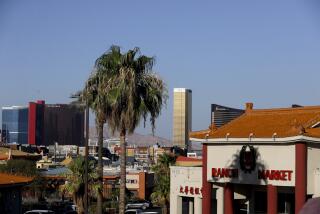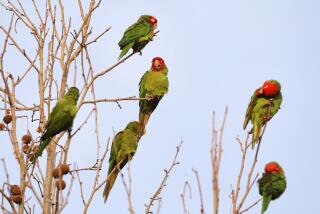In Las Vegas, where it seems most everything is legal, there is a new law: Don’t feed the pigeons
- Share via
Reporting from Las Vegas — Go ahead, carry that alcoholic beverage out onto the sidewalk with you — at 3 a.m., if you’d like. Gambling? Please do. Met the love of your life and are in a rush to get married? No waiting period here. Oh, and enjoy the honeymoon.
The Las Vegas Strip was built on fantasy. Escape from laws that make other places seems so button-down and straight. There’s a lot to be done in this famous stretch of glitz, lights and hedonism.
But whatever you do, don’t feed the pigeons.
The Clark County Commission passed a law that took effect Nov. 21 stating the feeding of feral pigeons would be a crime — a misdemeanor with a potential fine of $1,000 or six months in jail. A warning is more likely for a first-time offender, county officials said.
As in Clark County, pigeons have been a hotly contested topic for years around the world. Some high-profile bans, such as the one in Venice, Italy, came after the birds were deemed an extreme nuisance because their droppings were damaging historic monuments. Feeding them is banned in London’s Trafalgar Square, too.
Other tourists towns like San Francisco and Los Angeles have a patchwork of laws in place but mostly rely on signs to discourage bird feeders.
And, actually, some places don’t mind at all. In Puerto Rico, a scenic area in San Juan includes Parque de las Palomas, a small park that offers refuge for pigeons. Feeding them is OK in New York, too.
Not so on the Las Vegas Strip. County officials attempted to get an ordinance to control the birds passed in 2012, but that one didn’t fly. It was noteworthy, nevertheless, for the specificity it laid out in what kinds of pigeons couldn’t be fed — namely “the species Columba livia, also known as the City Pigeons, Rock Doves, Rock Pigeons or Flying Rats.”
Clark County resident Michelle Stewart took great umbrage at that last term during public comments at a commissioners meeting this month before the ordinance was approved. She mounted a defense for the pigeons, decrying the term “flying rats.” The current language simply refers to the birds as “wild pigeons.”
Stewart told the commission it wasn’t fair to penalize people who wanted to feed pigeons. She wore a T-shirt at the hearing that read “It’s Coo To Be Kind” and said she had fond memories of giving the birds treats with her grandparents.
“I can’t imagine not being able to feed the birds,” she said. “I could be having the worst day of my life and everything come crashing down, but when I get to go feed the birds, that’s something that makes my day.”
The hearing didn’t bring a lot of people to testify, but the handful of proponents and detractors were passionate.
Kevin McGowan, an ornithologist at Cornell University, said it’s not surprising that ordinances such as this get to people’s emotions.
He said pigeons were brought to the United States as domesticated animals by early settlers from Europe and were treated like chickens and turkeys — often to be consumed. Some were trained as homing pigeons, and the birds even have a history of war service as message carriers. He said there is a relationship between the birds and people that goes back a long way.
“We generally like each other,” he said.
But he said ordinances such as the one passed in Clark County help with the nuisance of large flocks congregating and perching on landmarks or damaging buildings with their acidic poop. Pigeons, he said, learn where food sources are and flocks watch each other to see where it’s plentiful. That’s when the birds gather en masse.
McGowan said pigeons are hardy birds that can eat most anything. But while the parents eat junk food, they have a milk source they give their fledglings that allow them to avoid devouring bad food. It’s full of nutrients and not empty like a potato chip.
“They’re reasonably smart birds,” he said. “And they’ve been living in cities for a long time and have learned to be open to a lot of different foods.”
While the ordinance covers much of the four-mile stretch of the Las Vegas Strip, it was born largely of trouble brewing beyond the Strip in unincorporated Clark County.
The West Flamingo Senior Center — a couple of miles west of the Strip — had become somewhat of an epicenter for perched pigeons. County Commission Chairman Steve Sisolak said some spots at the senior center saw six inches of pigeon poop accumulation after years of free feeding.
“It was a mess,” he said. “They had to clean it with a shovel. It caused the air-conditioning unit to break down.”
With the area’s triple-digit temperatures in the summer, a malfunctioning air conditioning unit isn’t a minor inconvenience either. A surge in solar panels on homes in Las Vegas, according to A Better Day Pigeon Control office manager Danielle Wagner, created a lot of new nesting opportunities for the birds, too.
Officials at the Flamingo senior center said the bird flock density could be thick enough to hide portions of the parking lot at times. Some days, it looked as if it were a casting call for a reboot of Alfred Hitchcock’s “The Birds.”
Supporters of the ordinance said it was necessary to keep repair costs down due to bird dropping damage and the potential for the spread of disease.
Sisolak said the Strip wasn’t the primary target of the law and the casinos never raised a stink to him about the birds bobbing and pecking about their properties as the ordinance was being considered.
That’s not to say pigeons don’t hang out around the area and its famous properties, however. Good eats for a resourceful bird can be found outside most restaurants and casinos south of Sahara Boulevard on the Las Vegas Strip.
Dave Kanellis, operations manager for Airborne Wildlife Control Service, said the waste from all of those buffets served at casinos are a big food source for pigeons. He said the ordinance probably will help keep the numbers down, but the pigeon population is unlikely to go the way of the 50-cent shrimp cocktail, either.
“All they need is food, water and shelter,” he said. “There’s plenty of that there.”
Kanellis, a falconer, said the pigeons are also a part of the local food chain. There are a number of peregrine falcons that live in the area, he said, and they engage in some population control by swooping down — even at night — amid the bright lights to take out pigeons.
“The falcons adapted to the environment,” he said.
To read the article in Spanish, click here
Twitter: @davemontero
More to Read
Sign up for Essential California
The most important California stories and recommendations in your inbox every morning.
You may occasionally receive promotional content from the Los Angeles Times.











